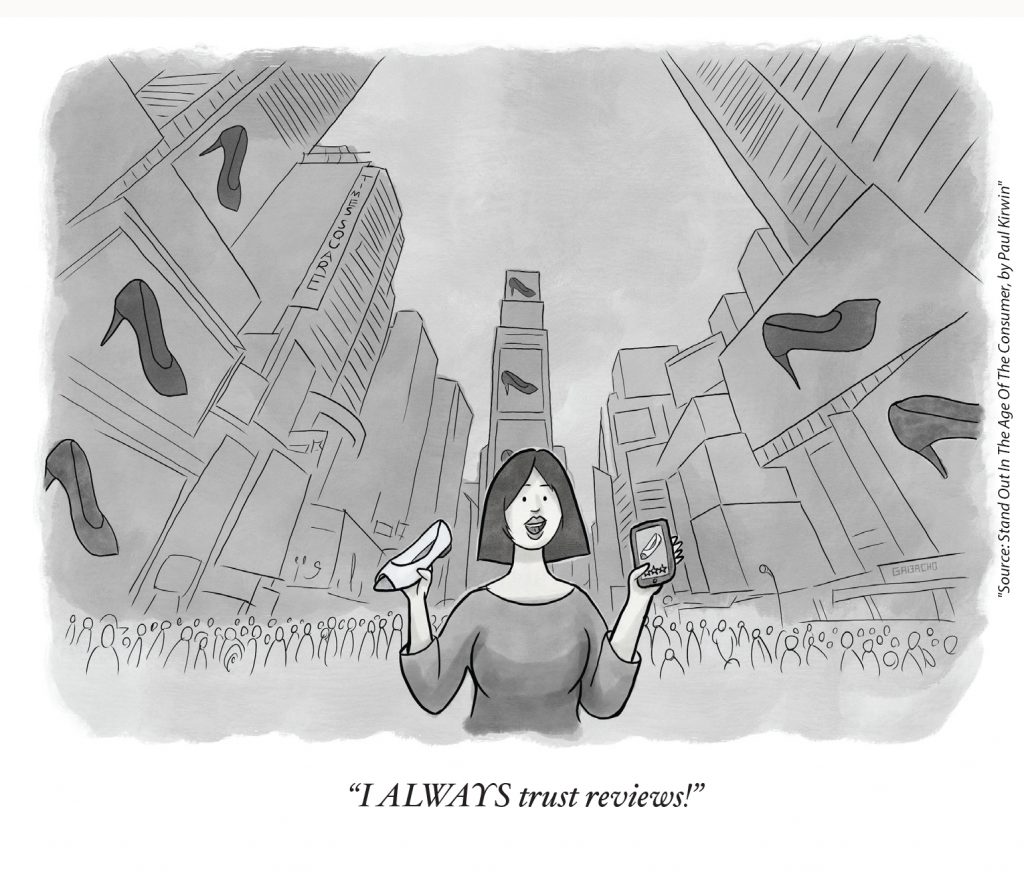
As has been often stated, 82% of consumers trust product reviews in the purchasing cycle (Pew). Their trust is second only to friends and family, by a single percentage point. That alone should tell you why product reviews matter. But let’s dive a little deeper into their importance to different stakeholders.
To Consumers
As word-of-mouth has evolved from ancient campfires to the internet, consumers have turned to the large database of online product reviews when making purchasing decisions. Less than 25% of consumers trust ads, with many finding ways to block them altogether. The connections that the Internet has spawned is one of the primary reasons why our founder Paul Kirwin wrote his book, Stand Out In The Age Of The Consumer. He says that, at the beginning, the Internet created a cocooning effect where people internalized. But it has evolved to foster every type of niche community, and product reviews (and their widespread adoption by consumers) are evidence of that.
To E-commerce Sites
Amazon, BestBuy, Target, Walmart and many other e-commerce sites have turned themselves into consumer opinion publishing houses. Reviews attract consumers to their site and keep them there. If there is volume and rich content in the reviews, people will stay and buy. These e-commerce sites are reaching millions of people a year, perhaps even in a month. If a site doesn’t have reviews, the user is likely to seek them out elsewhere. That’s a primary reason why 50% of searches begin on Amazon: reliability of reviews (Bloomberg).
To Brick & Mortar
The Brick & Mortar channel is starting to understand that reviews are also good for their business. 45% of Americans report using their cell phones in a store to look up product information including reviews (Pew). That means consumers are more educated when they’re in the store to touch, talk about and perhaps demo a product. They have money in their pocket. They are ready to buy. Half the selling process has already been done. Retail salespeople need to be experts in answering detailed questions and closing the deal.
To Brands
Brands have been slower to accept the power of product reviews than other stakeholders. The reason for this is the perceived loss of control. Consumers now have the forum to publicly discuss their experience, what they want and what they would change about a product. For the brands, the ability to “buy” a consumer’s opinion via mass advertising, even to the tune of millions spent, is more compelling than this perceived loss of control. What seems to be a mystery to these slow-to-adopt brands is that the user experience, through product reviews, is now the most powerful force in the marketplace. Only 10% of buyers write reviews, yet this 10% who publish their user experience, reach deep into the public marketplace. This is a brand’s most reliable, trusted and powerful sales message in 2019.
Product Reviews as a Data Set: What Makes Them Different?
There are three key differentiators between product reviews and other Voice of the Consumer tools.
- Speed. Unlike other VoC tools, such as surveys (which take effort to create and run), most established brands have a large dataset of reviews. Those reviews come in quickly following a product’s entry into the marketplace.
- Authenticity. Survey bias is an age old topic that goes beyond surveys into focus groups, research panels and more. The nature of the questions and the desire of the panel to provide the “right” answers creates bias. The fact that reviews take place on the Web eliminates this problem.
- Two-Way Influence. For brands, the influence goes two ways. These reviews are not only a tremendous sales tool, but also include data about the user’s experience with a product. It is gold to product development, marketing and sales.
How Brands Regain Control
Channel Signal gives brands a tool that calculates the impact of their bad reviews with recent buyers and the impact going forward when future buyers read these reviews. But the buck doesn’t stop there. Channel Signal identifies the issues behind those 1 and 2 star reviews, written by the consumers, that are holding the product back. If the brand fixes these issues, the new, improved impact can be calculated. In other words, the problem and potential solutions can be quantified with Channel Signal.
Bad Reviews Cost You Money. Let’s Do The Math.

Enter an Amazon product URL to see the impact your 1 and 2 star reviews are having on both your online and offline sales.

